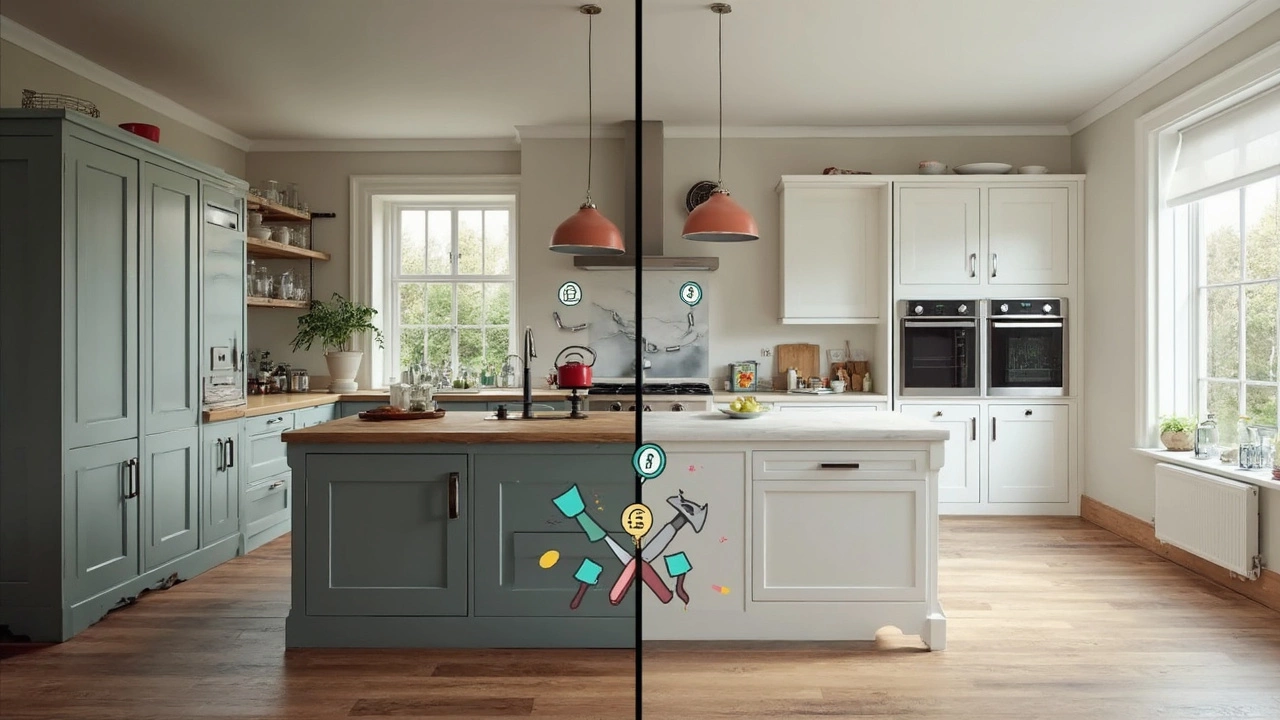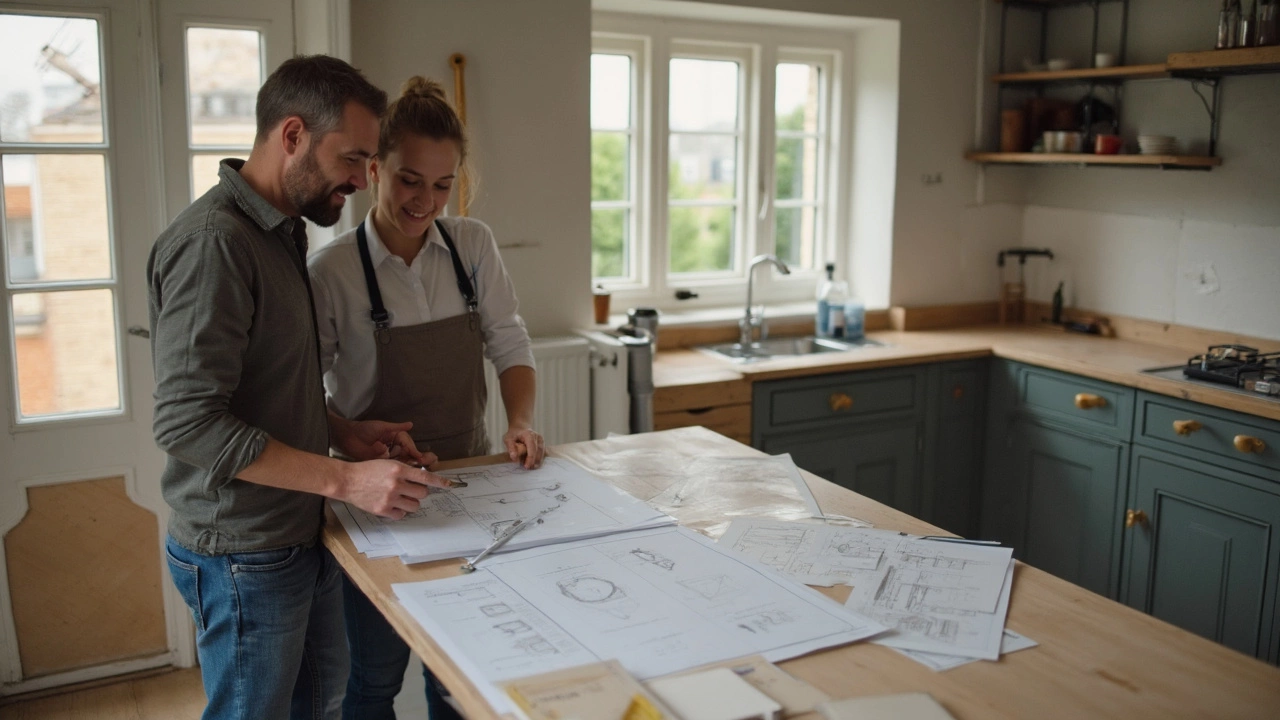Kitchen fitting prices can shock you if you don’t know what you’re looking at. There’s no flat rate, so getting a real number can feel like searching for your keys in a junk drawer. Most kitchen fitters won’t just toss out one price because so much depends on your choices, your space, and even the time of year you book.
Let’s get right to it: in the UK, the average charge for a standard kitchen fitting (not including the cost of cabinets or appliances) usually runs between £1,500 and £3,000 for smaller kitchens, but big, complicated jobs in London or the South East can push past £5,000—sometimes higher if you’ve got fancy extras or awkward layouts.
That’s just the labor, not the shiny new stove or the posh taps. And no, most installers won’t be keen to give you an exact quote after a two-minute phone chat—it’s all about the details. The more walls to move, floors to level, or pipes to reroute, the higher the bill goes. The safest bet? Always get a breakdown before signing anything.
- What Does Kitchen Fitting Actually Include?
- Average Costs: What Most People Pay
- What Impacts the Price?
- Ways to Save on Kitchen Installation
- Red Flags & Choosing the Right Installer
What Does Kitchen Fitting Actually Include?
If you think kitchen fitting is just screwing in cabinets, you’re missing half the story. A kitchen installation is a mix of trades—sometimes way more involved than people expect. Installers aren’t just woodworkers; many handle electricals, plumbing, tiling, and floors. If your place is old or has awkward quirks, it’ll take even more fiddling.
Here’s what usually makes up a kitchen fitting cost:
- Removing the old kitchen: Ripping out cupboards, worktops, sinks, and appliances. This part can get messy and often exposes hidden problems (like sketchy wiring or leaks).
- Prepping the space: Patching up walls, making sockets safe, sorting out dodgy pipes, and maybe leveling the floor.
- Installing new units: Lining up and fixing cupboards and pan drawers to the walls and floor so nothing wobbles (or falls).
- Worktops and tiling: Fitting the surfaces and splashbacks, cutting around sinks and hobs, and dealing with joins so water doesn’t sneak in.
- Plumbing and electrics: Hooking up taps, drains, dishwashers, cookers, ovens, cooker hoods, and sometimes even new lighting. Legally, some stuff has to be done by certified folks.
- Finishing touches: Sealing edges, adding handles, maybe fitting in appliances, and double-checking everything works like it should.
If it’s a big job—say, knocking down walls or rewiring the whole place—expect to bring in extra trades, and that bumps up your kitchen installation bill even more.
A survey by Which? in 2024 found that 69% of homeowners needed at least three different trades to finish their new kitchens. That’s a lot of skills under one roof.
“A proper kitchen installation is rarely a solo act. Each one is unique and often uncovers surprises—good fitters know how to handle them and keep moving.” — Mike Headley, Master Installer at the British Institute of Kitchen, Bedroom & Bathroom Installation (BiKBBI)
Some fitters offer a one-stop-shop and will project manage the whole thing—this saves you headaches but usually costs a bit more.
Average Costs: What Most People Pay
The cost of kitchen fitting almost always depends on how big your space is, where you live, and how much you want done. Still, most folks in the UK end up paying somewhere between £1,500 and £3,000 for a straightforward fitting job. This usually covers the basics: ripping out the old units, putting in the new cabinets, fitting worktops, hanging doors, and making things level and tidy. The installer might charge extra if you want the splashback tiled or the floor sorted.
If you’re in London, expect to pay at the higher end, maybe even more. City living always bumps the price up, mostly because of higher business costs, parking woes, and just general demand. In northern regions or smaller towns, you might get a deal closer to that £1,500 mark—especially for smaller setups.
Let’s break it down with some real ballpark numbers for kitchen installation:
| Kitchen Size | Low End (£) | High End (£) |
|---|---|---|
| Small | 1,500 | 2,500 |
| Medium | 2,000 | 4,000 |
| Large | 3,000 | 6,500+ |
That’s just for fitting. If you want new plumbing or wiring sorted, you’ll probably see another £500 to £1,500 depending on complexity. Got an island, fancy lighting, or one of those boiling-water taps? Plan for more.
Don’t forget—some installers will charge a day rate, usually around £150–£250 per day. A simple job might take a week. Bigger, custom projects can easily stretch to two weeks or longer. Get a detailed quote that’s clear on what’s included, so you don’t get caught out halfway by “surprise” extras.
Handy tip: always ask if the installer’s price covers things like waste disposal and finishing bits. Some fitters throw that in, others count it as extra. That way you can compare quotes properly, apples for apples.

What Impacts the Price?
If you’ve ever wondered why your mate got his kitchen fitted for half of what you’re being quoted, you’re not alone. The price for kitchen fitting cost can jump around a lot, and it’s usually down to a handful of real-world factors. Here’s what you should keep an eye on:
- Size of the Kitchen: Obvious, but easy to underestimate. Bigger kitchens mean more cupboards, longer worktops, and more time on site.
- Layout Changes: If you stick to the old layout, prices stay lower. But if you want the sink on the other side or a wall knocked through, expect higher costs for rerouting pipes and cables.
- Type of Units and Worktops: Flat-pack IKEA units are quicker to fit than bespoke solid oak cabinets. Same goes for worktops: laminate is cheaper to fit than stone or quartz, which need special tools (and muscle).
- Old Kitchen Rip-Out: Some fitters include this, others don’t. Taking out stubborn old tiles or dealing with dodgy electrics under the floorboards can add hours—sometimes days—to the job.
- Extras: Spotlights, under-cabinet lighting, fancy splashbacks, integrated appliances—all these add time and specialist skills. Fancy upgrades look great but can wreck the budget.
- Location: If you live in London or the South East, just accept you’ll pay more in labor charges than someone up north. That’s just how it goes, with fitters often charging 15-25% more in these regions.
Curious about how these factors stack up in real life? Here’s a table showing average UK kitchen installation rates based on major cost changers:
| Factor | Basic Kitchen (£) | Premium Kitchen (£) |
|---|---|---|
| Small (8 unit) kitchen, simple install | 1,500 – 2,000 | 3,000 – 4,000 |
| Medium (12 unit) kitchen, minor changes | 2,000 – 3,000 | 4,500 – 6,000 |
| Large kitchen, lots of extras/structural | 3,500+ | 7,000+ |
Planning to get a kitchen installer? Always ask for a site inspection and get everything in writing—no one wants to find out too late that moving a gas pipe means an extra grand on the invoice.
Ways to Save on Kitchen Installation
Fitting a new kitchen doesn’t have to wreck your savings. If you know where to cut costs (without cutting quality), you’ll walk away with a slick kitchen and money left for the first week’s takeaway. Here’s how you can keep that kitchen fitting cost in check.
- Get Multiple Quotes: Don’t just accept the first price handed to you. Get 3 to 5 detailed quotes from different kitchen installation pros. This helps you spot overpriced deals and filter out installers with sketchy details or no breakdown.
- Do Simple Tasks Yourself: If you’re handy, rip out old units, remove tiles, or handle painting. Installers won’t always tell you this, but shifting all that old stuff yourself knocks hours off the job—and you won’t pay for the privilege.
- Keep the Layout Similar: Moving sinks, ovens, or gas lines shoots up the price fast. If you can work with the existing plumbing and wiring, the job becomes a lot cheaper and faster.
- Source Your Own Materials: Shop around. Buying your own worktops, tiles, or even basic cabinets can be cheaper than letting the installer provide everything. Just check with your fitter first to avoid sizing mixups.
- Be Upfront About the Budget: There’s no shame in saying, “This is what I have—what can we do?” An honest chat with your installer can help them recommend money-saving swaps or skip fancy but unnecessary upgrades.
If you’re living in a city, prepare to pay a little more, but you can still avoid top-tier rates by avoiding high-street chains or big showrooms—their markup is sometimes double what independent trades charge for the exact same job.
| Region | Typical Labor Cost |
|---|---|
| London | £3,000 - £5,500 |
| South East | £2,800 - £5,000 |
| Northern England | £1,500 - £3,200 |
| Scotland | £1,400 - £3,000 |
Timing matters too. Booking your kitchen installer for winter or early spring (when work tends to dry up) could lead to better deals, as fitters will be eager for the job. Just make sure to always check reviews and get everything in writing, whether you’re cutting costs or going for the works.

Red Flags & Choosing the Right Installer
Picking the wrong pro to handle your kitchen installation can wreck your budget and your nerves. You’ll want someone who shows up, knows their stuff, and actually cares if your kitchen ends up looking good. Here’s what to watch out for—and how to make sure you get someone decent.
- Zero written quote: If a fitter won’t give you a detailed, written quote, run. Shady installers avoid putting things in writing so they can wiggle out of promises or tack on hidden costs later.
- No references or portfolio: Even the best kitchen fitters usually have piles of before-and-after pics, or happy customers who’d chat for five minutes. If your installer gets cagey about references, trust your gut.
- Crazy low bids: Sure, it’s tempting to save a few hundred pounds, but a quote out of line with most others can mean cheap materials, rushed work, or worse. Real pros know what things cost and don’t work for peanuts.
- Refusing a site visit: Any good installer will want to eyeball your space. If they skip this and just throw a number at you over text, that’s a red flag.
- No insurance or registration: Ask to see proof of public liability insurance. For gas or electrical jobs, installers need the right papers—like Gas Safe registration or NICEIC approval. No paperwork? Move on.
So, how do you actually find the right kitchen installer?
- Get at least three quotes: Comparing written quotes side-by-side makes weird prices or missing details stand out.
- Check online reviews: Real customers on sites like Trustpilot, Checkatrade, or Google often spill the truth about how reliable the fitter really is.
- Ask about previous jobs: If they’ve installed kitchens similar to yours from big brands (like Howdens, Wickes, Magnet), that’s a plus. Many top fitters list brands they’ve worked with.
- Agree on a payment plan: Don’t pay in full upfront. Most fitters take a small deposit, then split the rest after specific milestones—like demo, fitting, and final touch-ups.
According to a 2024 UK trade survey, only about 57% of homeowners were completely happy with their first choice of kitchen installer. The rest had issues—mainly with lack of communication or corners being cut on the job (kitchen fitting cost is rarely the only problem!). Taking a bit more time at this stage can save you serious stress and expense.
| Red Flag | Why It Matters |
|---|---|
| No written quote | Hard to hold installer accountable; surprise costs likely |
| No insurance | No cover if things go wrong or someone gets hurt |
| Cuts corners on paperwork | Can’t legally do gas/electrical work (dangerous and illegal) |
| Doesn’t answer questions clearly | Probably hiding a lack of skill or experience |
So, trust your instincts and don’t skip the background checks. A dependable kitchen installation pro is worth their weight in gold—or at least in undamaged cupboards and worry-free project updates.





